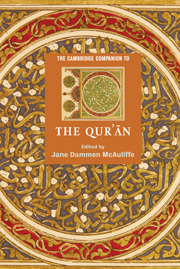Book contents
- Frontmatter
- Introduction
- Part I Formation of the Qur'ānic text
- Part II Description and analysis
- Part III Transmission and dissemination
- Part IV Interpretations and intellectual traditions
- Part V Contemporary readings
- 12 Women’s readings of the Qur'ān
- 13 Political interpretation of the Qur'ān
- 14 The Qur'ān and other religions
- Qur'ān Citation Index
- General Index
12 - Women’s readings of the Qur'ān
from Part V - Contemporary readings
Published online by Cambridge University Press: 28 March 2007
- Frontmatter
- Introduction
- Part I Formation of the Qur'ānic text
- Part II Description and analysis
- Part III Transmission and dissemination
- Part IV Interpretations and intellectual traditions
- Part V Contemporary readings
- 12 Women’s readings of the Qur'ān
- 13 Political interpretation of the Qur'ān
- 14 The Qur'ān and other religions
- Qur'ān Citation Index
- General Index
Summary
Some 1,400 years ago, when the Qur'ān was being revealed to the prophet Muhammad, his wife Umm Salama reportedly asked him why it was not addressing women. It seems she was not impressed by the fact that in the Arabic language, as in many others, the male gender is inclusive of the female and that in using it the Qur'ān was, in effect, addressing both. Of course if this had been an idle question on her part and nothing had come of it, the incident probably would not have found its way into Muslim tradition. Yet, not only does tradition record it, but many Muslims use it to explain the context in which the Qur'ān became the only scripture to speak directly to women.
Women in the Qur'Ān
Indeed, not only does the Qur'ān address women, but it frequently does so in a manner that should leave little room for doubt that it considers them equal to men. One example is Q 33:35: 'For Muslim men and women, for believing men and women, for devout men and women, for men and women who are patient and constant, for men and women who humble themselves, for men and women who give in charity, for men and women who fast (and deny themselves), for men and women who guard their chastity, and for men and women who engage much in God's praise; for them has God prepared forgiveness and great reward.' In spite of such verses, and the Qur'ān's counsel to read it for its best meanings, most Muslims continue to project sexual inequality, discrimination and even misogyny into it. Before considering why this is so, it seems appropriate to dwell for a bit on Umm Salama's question since it offers such compelling and potentially unending lessons for believers.
- Type
- Chapter
- Information
- The Cambridge Companion to the Qur'ān , pp. 255 - 272Publisher: Cambridge University PressPrint publication year: 2006
- 13
- Cited by



